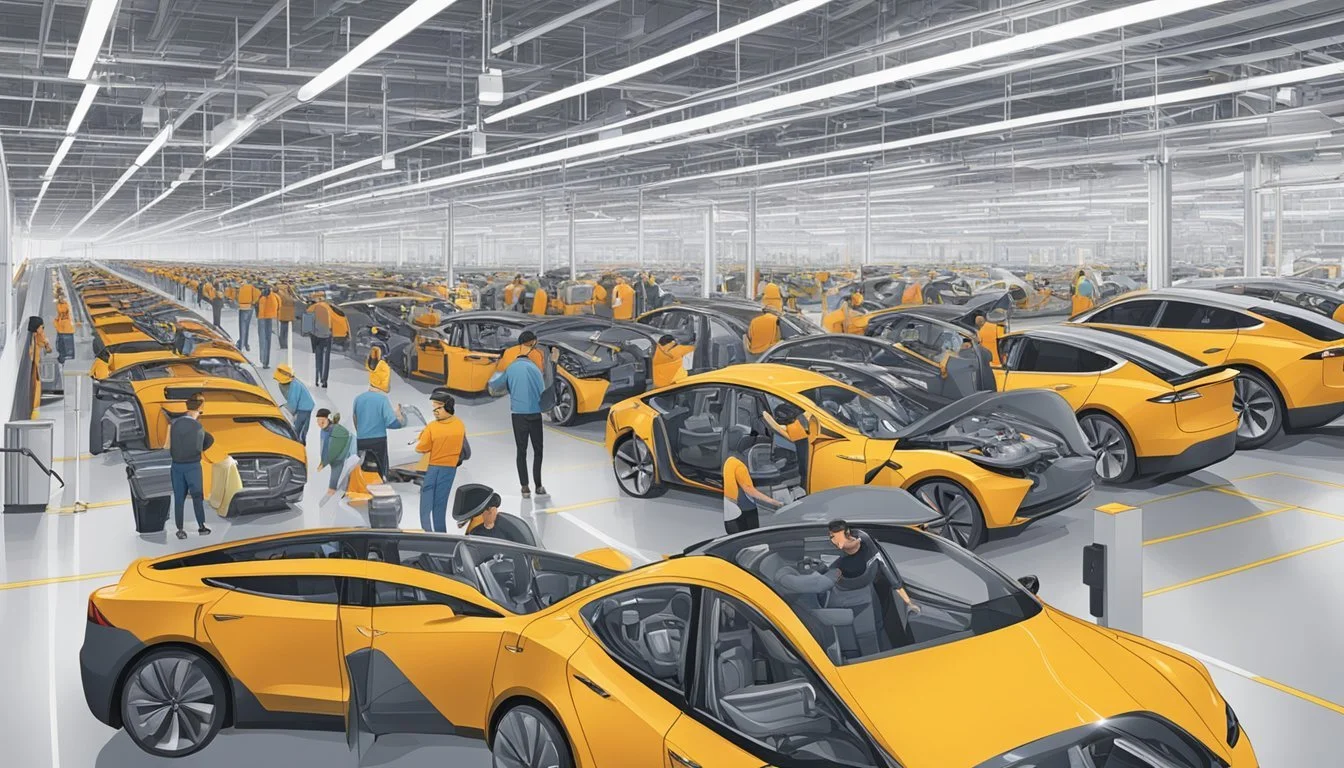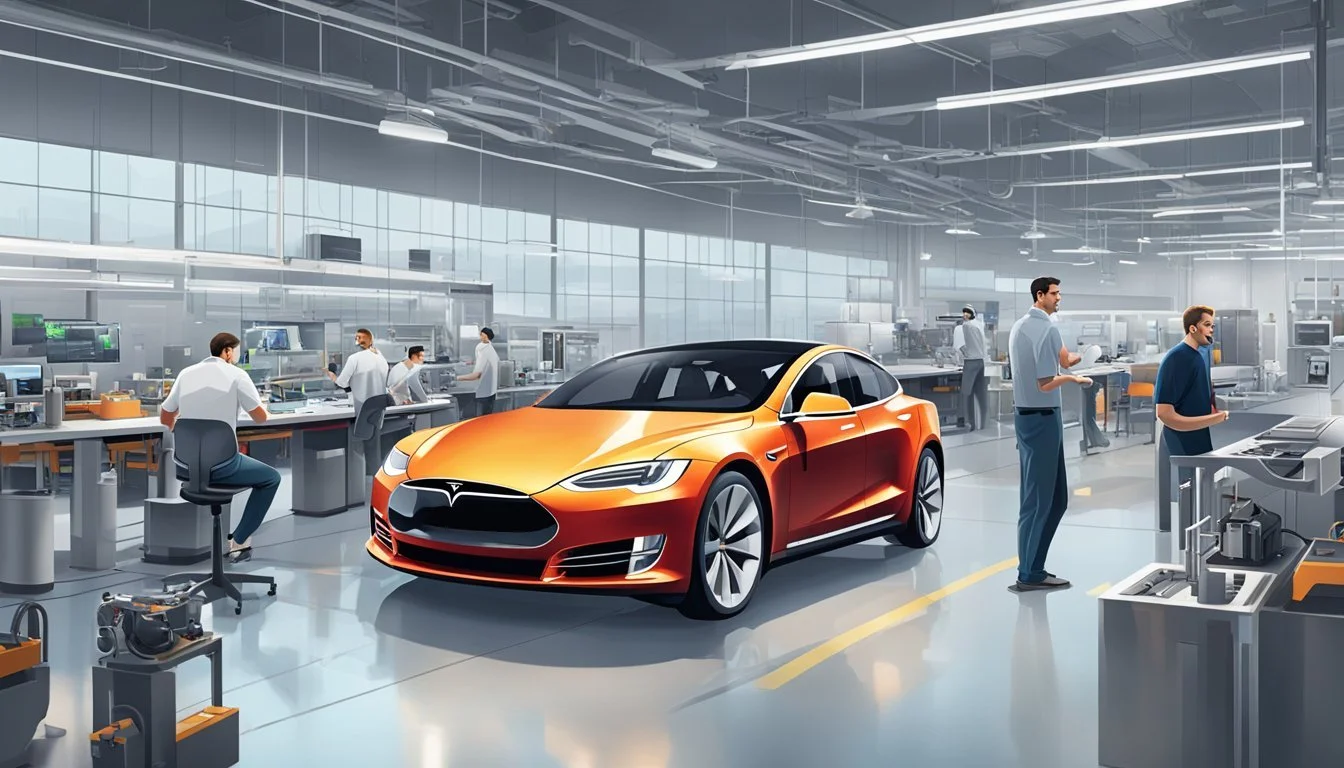Tesla Austin Expansion: $770 Million Boost to Gigafactory Texas!
Tesla's expansion plans for its Austin Gigafactory are taking shape. The electric vehicle manufacturer has filed permits to invest $770 million in expanding its Texas facility. This expansion aims to double the size of the current factory, signaling Tesla's commitment to scaling up production in the Lone Star State.
The Austin Gigafactory, which officially opened in April 2022, currently produces Model Y crossover vehicles. With the proposed expansion, Tesla is poised to increase its manufacturing capabilities and potentially introduce new product lines. The company's filings with the Texas Department of Licensing and Regulation reveal little about specific plans, but industry observers speculate this move could support the production of the highly anticipated Cybertruck.
Tesla's substantial investment in Austin underscores the strategic importance of the Texas Gigafactory to the company's growth strategy. As the automaker continues to push for increased production capacity, this expansion positions Tesla to meet rising demand for electric vehicles and solidify its foothold in the competitive automotive market.
Background of Tesla in Austin
Tesla's presence in Austin, Texas represents a major expansion for the electric vehicle manufacturer. The Gigafactory Texas facility highlights Tesla's commitment to increasing production capacity and creating jobs in the United States.
Genesis of Giga Texas
Tesla announced plans for its Austin Gigafactory in July 2020. Construction began swiftly, with limited Model Y production starting by late 2021. The factory officially opened in April 2022 with a "Cyber Rodeo" event attended by 15,000 people.
Located in Travis County just outside Austin, the facility spans over 2,000 acres. It serves as a manufacturing hub for Tesla vehicles and batteries. The Texas Department of Licensing and Regulation has approved permits for Tesla's ongoing construction and expansion efforts at the site.
Strategic Significance of the Austin Location
Choosing Austin for Gigafactory Texas provided Tesla with several strategic advantages. The central U.S. location improves distribution logistics for Tesla's products. Texas offers business-friendly policies and a skilled workforce.
The factory has already created over 5,000 jobs in the area. Tesla aims to further boost local employment and economic growth through its expansion plans. The Austin Gigafactory is slated to produce the Cybertruck and new, more affordable Tesla models in the coming years.
Travis County and Texas state officials provided incentives to attract Tesla's investment. This collaboration between Tesla and local authorities has positioned the Austin area as an emerging hub for electric vehicle and technology innovation.
Economic Impact of Tesla's Expansion
Tesla's expansion in Austin has generated substantial economic benefits for the region. The company's investment and job creation have spurred growth across multiple sectors of the local economy.
Job Creation and Investment
Tesla's Gigafactory in Austin has created over 15,000 jobs since its opening. The company invested $5.8 billion in the factory's construction, with plans to invest over $10 billion in total. During peak construction, the workforce reached 5,000-6,000 employees.
In 2022, Tesla paid $469 million in wages at its Austin facility. This influx of high-paying jobs has boosted local spending power and stimulated economic activity.
The company's presence has also attracted suppliers and partners, further expanding job opportunities in the region.
Regional Economic Growth
Tesla's expansion has generated significant tax revenue for local governments. From 2020 to the end of 2024, Tesla estimates it will have paid $15 million in taxes to Travis County and over $49 million to Del Valle ISD.
The company's economic impact extends beyond direct contributions. Tesla's presence has attracted other businesses to the area, creating a ripple effect across various industries.
Local businesses have benefited from increased customer traffic and spending. The real estate market has seen growth as new employees seek housing in the region.
Tesla's innovation hub has also bolstered Austin's reputation as a tech center, potentially attracting more high-tech companies and talent to the area.
Factory Infrastructure and Production Capabilities
Tesla's Austin Gigafactory boasts cutting-edge manufacturing facilities and innovative production methods. The sprawling complex houses advanced equipment and streamlined processes to maximize output efficiency.
Manufacturing Processes and Facilities
The Austin Gigafactory features state-of-the-art production lines for vehicle assembly. Its body shop uses high-precision robots for welding and joining vehicle frames. The paint shop applies multiple coats using advanced spraying techniques for a flawless finish.
A massive stamping press forms large body panels from sheet metal. The factory's casting area produces single-piece rear and front underbody components, reducing complexity and parts count.
The facility's plastics division molds interior components and body panels. Final assembly brings all elements together on a moving production line.
Innovations in Production Efficiency
Tesla implements several innovations to boost production efficiency. The Giga Press, a colossal die-casting machine, creates large single-piece components that replace dozens of smaller parts.
Advanced robotics and automation systems work alongside human employees throughout the manufacturing process. This synergy increases precision and speed while reducing labor costs.
Tesla's production software optimizes workflow and tracks each vehicle through assembly. Real-time data analysis allows for quick adjustments to improve efficiency.
The factory's layout minimizes material movement between production stages, reducing time and energy waste. Tesla continually refines its manufacturing techniques to increase output and quality.
Tesla's Electric Vehicles and Production
Tesla's Austin Gigafactory plays a crucial role in the company's electric vehicle productionstrategy. The facility focuses on manufacturing popular models and innovative new offerings to meet growing demand.
Model Y and Model 3 Production
The Austin Gigafactory primarily produces the Model Y, Tesla's compact SUV. This high-volume vehicle is a key driver of the company's growth. The factory's advanced manufacturing processes enable efficient production of Model Y components, including battery packs and drive units.
Tesla aims to ramp up Model Y production at the Austin facility to reach 5,000 vehicles per week. This goal aligns with the company's efforts to increase overall output and reduce wait times for customers.
The factory also has the capability to produce the Model 3 sedan. Tesla may adjust production lines to accommodate both models based on market demand and production targets.
Anticipated Cybertruck Launch
Tesla's distinctive Cybertruck is slated for production at the Austin Gigafactory. The electric pickup truck's unique design and features have generated significant interest since its unveiling.
Production of the Cybertruck is expected to begin in the near future, with Tesla making preparations to integrate it into the factory's production lines. The company is working to ensure the necessary equipment and processes are in place for Cybertruck manufacturing.
Tesla aims to capitalize on the growing electric truck market with the Cybertruck's launch. The Austin facility's expansion plans may include dedicated areas for Cybertruck production to meet anticipated demand.
Battery Innovation and Supply Chain
Tesla's battery innovations and supply chain strategies are reshaping the electric vehicle industry. The company's focus on in-house cell production and vertical integration aims to secure a competitive advantage in the EV market.
4680 Cell Manufacturing
Tesla's 4680 battery cell is a cornerstone of its innovation efforts. This larger, more efficient cell design promises increased energy density and reduced production costs. Tesla's Gigafactory in Austin, Texas is ramping up 4680 cell production, with capacity for over 1,000 cars per week as of December. The company plans to expand its Nevada facility to produce 100 gigawatt-hours of 4680 cells annually.
The 4680 cells undergo rigorous testing to ensure performance and safety standards. Tesla's cathode technology improvements contribute to the cells' enhanced capabilities.
Supply Chain Integration
Tesla is actively expanding its battery supply chain to meet growing EV demand. While maintaining partnerships with suppliers like Panasonic, the company is investing heavily in its own production capabilities. This vertical integration strategy aims to reduce costs and improve supply chain resilience.
The Austin Gigafactory expansion includes significant battery-related projects. These investments will increase Tesla's control over critical components and materials. By bringing more of the battery production process in-house, Tesla seeks to mitigate supply chain risks and accelerate innovation cycles.
Tesla's Research and Development Efforts
Tesla's commitment to innovation drives its expansion in Austin. The company focuses on cutting-edge battery technology and advanced drivetrain systems to maintain its competitive edge in the electric vehicle market.
Cell Test Lab and Innovation
Tesla's Cell Test Lab in Austin plays a crucial role in battery development. The facility conducts extensive testing on new cell chemistries and designs. Engineers work to improve energy density, charging speeds, and overall battery performance.
The lab utilizes advanced equipment to simulate real-world conditions and stress tests. This ensures Tesla's batteries meet stringent safety and longevity standards.
Tesla's Investor Day highlighted plans for next-generation battery technology. The company aims to reduce production costs while increasing range and performance.
Drive Unit Advancements
Tesla's Austin facility houses a dedicated drive unit development team. They focus on improving efficiency, power output, and manufacturing processes for electric motors and transmissions.
The team works on reducing the size and weight of drive units while increasing power density. This effort contributes to Tesla's goal of extending vehicle range and enhancing performance.
Recent advancements include new motor designs that reduce rare earth material usage. Tesla also explores novel cooling systems to optimize drive unit performance under various conditions.
The Austin R&D center collaborates closely with production teams to streamline manufacturing processes. This integration accelerates the implementation of new technologies into Tesla's vehicle lineup.
Companies and Societal Impact
Tesla's expansion in Austin extends beyond its factory walls, influencing local communities and the broader transportation landscape. The company's presence brings economic opportunities while pushing forward electric vehicle adoption and autonomous driving technologies.
Collaboration Between Tesla and Local Entities
Tesla's Gigafactory in Travis County has fostered partnerships with local organizations. The company has supported over 15,000 jobs in the area through direct employment and supply chain expansion. This economic boost has ripple effects across the region, stimulating growth in various sectors.
Tesla works closely with Travis County officials to ensure its expansion aligns with local development goals. The company's $770 million investment plan for factory expansion demonstrates its commitment to the area's long-term economic prosperity.
Local educational institutions benefit from Tesla's presence, with opportunities for internships and research collaborations. This partnership helps cultivate a skilled workforceready for the evolving automotive industry.
Tesla's Role in the Future of Transportation
Tesla's Austin Gigafactory plays a crucial role in shaping the future of transportation. The facility focuses on producing electric vehicles and developing autonomous driving technology, positioning Texas at the forefront of automotive innovation.
The company's expansion in Austin accelerates the development of its Robotaxi program. This initiative aims to revolutionize urban mobility by introducing a fleet of self-driving vehicles for ride-hailing services.
Tesla's increased production capacity in Austin complements its existing facilities in Fremont and Nevada. This network of Gigafactories enables Tesla to meet growing demand for electric vehicles, driving widespread adoption of sustainable transportation solutions.
The Austin Gigafactory serves as a hub for battery technology advancements, crucial for improving electric vehicle range and performance. These innovations have far-reaching implications for renewable energy storage and grid stability.




